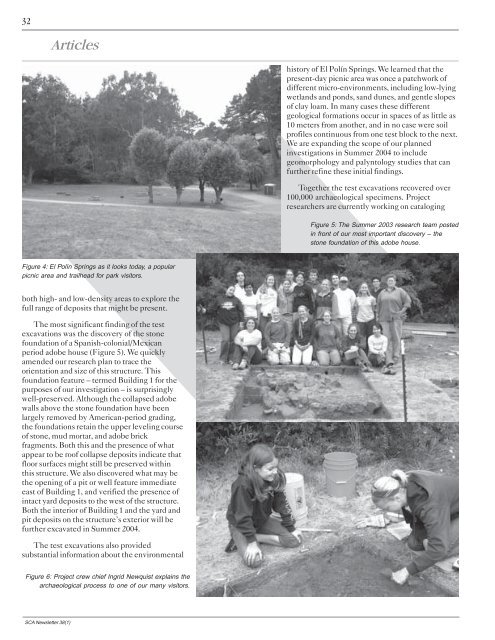March 2004 - Society for California Archaeology
March 2004 - Society for California Archaeology
March 2004 - Society for California Archaeology
Create successful ePaper yourself
Turn your PDF publications into a flip-book with our unique Google optimized e-Paper software.
32<br />
Articles<br />
history of El Polín Springs. We learned that the<br />
present-day picnic area was once a patchwork of<br />
different micro-environments, including low-lying<br />
wetlands and ponds, sand dunes, and gentle slopes<br />
of clay loam. In many cases these different<br />
geological <strong>for</strong>mations occur in spaces of as little as<br />
10 meters from another, and in no case were soil<br />
profiles continuous from one test block to the next.<br />
We are expanding the scope of our planned<br />
investigations in Summer <strong>2004</strong> to include<br />
geomorphology and palyntology studies that can<br />
further refine these initial findings.<br />
Together the test excavations recovered over<br />
100,000 archaeological specimens. Project<br />
researchers are currently working on cataloging<br />
Figure 5: The Summer 2003 research team posted<br />
in front of our most important discovery – the<br />
stone foundation of this adobe house.<br />
Figure 4: El Polín Springs as it looks today, a popular<br />
picnic area and trailhead <strong>for</strong> park visitors.<br />
both high- and low-density areas to explore the<br />
full range of deposits that might be present.<br />
The most significant finding of the test<br />
excavations was the discovery of the stone<br />
foundation of a Spanish-colonial/Mexican<br />
period adobe house (Figure 5). We quickly<br />
amended our research plan to trace the<br />
orientation and size of this structure. This<br />
foundation feature – termed Building 1 <strong>for</strong> the<br />
purposes of our investigation – is surprisingly<br />
well-preserved. Although the collapsed adobe<br />
walls above the stone foundation have been<br />
largely removed by American-period grading,<br />
the foundations retain the upper leveling course<br />
of stone, mud mortar, and adobe brick<br />
fragments. Both this and the presence of what<br />
appear to be roof collapse deposits indicate that<br />
floor surfaces might still be preserved within<br />
this structure. We also discovered what may be<br />
the opening of a pit or well feature immediate<br />
east of Building 1, and verified the presence of<br />
intact yard deposits to the west of the structure.<br />
Both the interior of Building 1 and the yard and<br />
pit deposits on the structure’s exterior will be<br />
further excavated in Summer <strong>2004</strong>.<br />
The test excavations also provided<br />
substantial in<strong>for</strong>mation about the environmental<br />
Figure 6: Project crew chief Ingrid Newquist explains the<br />
archaeological process to one of our many visitors.<br />
SCA Newsletter 38(1)

















